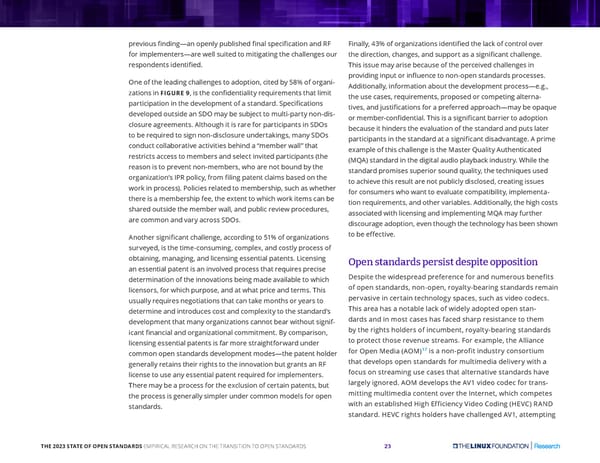previous finding—an openly published final specification and RF Finally, 43% of organizations identified the lack of control over for implementers—are well suited to mitigating the challenges our the direction, changes, and support as a significant challenge. respondents identified. This issue may arise because of the perceived challenges in One of the leading challenges to adoption, cited by 58% of organi- providing input or influence to non-open standards processes. FIGURE 9, is the confidentiality requirements that limit Additionally, information about the development process—e.g., zations in the use cases, requirements, proposed or competing alterna- participation in the development of a standard. Specifications tives, and justifications for a preferred approach—may be opaque developed outside an SDO may be subject to multi-party non-dis- or member-confidential. This is a significant barrier to adoption closure agreements. Although it is rare for participants in SDOs because it hinders the evaluation of the standard and puts later to be required to sign non-disclosure undertakings, many SDOs participants in the standard at a significant disadvantage. A prime conduct collaborative activities behind a “member wall” that example of this challenge is the Master Quality Authenticated restricts access to members and select invited participants (the (MQA) standard in the digital audio playback industry. While the reason is to prevent non-members, who are not bound by the standard promises superior sound quality, the techniques used organization’s IPR policy, from filing patent claims based on the to achieve this result are not publicly disclosed, creating issues work in process). Policies related to membership, such as whether for consumers who want to evaluate compatibility, implementa- there is a membership fee, the extent to which work items can be tion requirements, and other variables. Additionally, the high costs shared outside the member wall, and public review procedures, associated with licensing and implementing MQA may further are common and vary across SDOs. discourage adoption, even though the technology has been shown Another significant challenge, according to 51% of organizations to be effective. surveyed, is the time-consuming, complex, and costly process of obtaining, managing, and licensing essential patents. Licensing Open standards persist despite opposition an essential patent is an involved process that requires precise determination of the innovations being made available to which Despite the widespread preference for and numerous benefits licensors, for which purpose, and at what price and terms. This of open standards, non-open, royalty-bearing standards remain usually requires negotiations that can take months or years to pervasive in certain technology spaces, such as video codecs. determine and introduces cost and complexity to the standard’s This area has a notable lack of widely adopted open stan- development that many organizations cannot bear without signif- dards and in most cases has faced sharp resistance to them icant financial and organizational commitment. By comparison, by the rights holders of incumbent, royalty-bearing standards licensing essential patents is far more straightforward under to protect those revenue streams. For example, the Alliance common open standards development modes—the patent holder for Open Media (AOM)17 is a non-profit industry consortium generally retains their rights to the innovation but grants an RF that develops open standards for multimedia delivery with a license to use any essential patent required for implementers. focus on streaming use cases that alternative standards have There may be a process for the exclusion of certain patents, but largely ignored. AOM develops the AV1 video codec for trans- the process is generally simpler under common models for open mitting multimedia content over the Internet, which competes standards. with an established High Efficiency Video Coding (HEVC) RAND standard. HEVC rights holders have challenged AV1, attempting THE 2023 STATE OF OPEN STANDARDS EMPIRICAL RESEARCH ON THE TRANSITION TO OPEN STANDARDS 23
 The 2023 State of Open Standards Page 22 Page 24
The 2023 State of Open Standards Page 22 Page 24